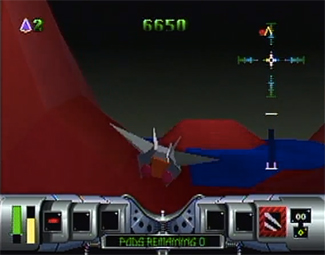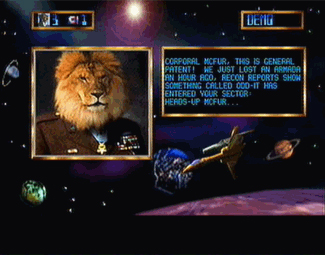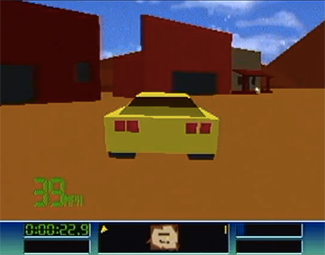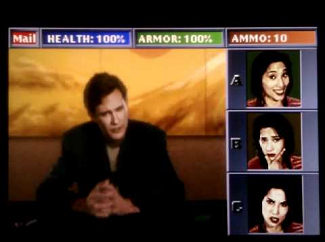

B.J. West interview
By Ross Sillifant
(2017)
Q: It is with great pleasure Iím able to put questions to a Mr. B.J. West. Sir, if you would be so kind, please introduce yourself to our readers.
B.J. West: I'm a graphic artist and filmmaker, based in the San Francisco Bay Area. I worked in the games industry for almost 12 years, contributing to some of the best and worst-selling games of all time. My best-know work would be creating in-game objects for The Sims franchise, from the original game, several expansion packs, The Sims Online, and The Sims 2.0, as well as SimCity 3000. I got out of the industry to transition to visual effects for film in 2004, and have worked on several award-winning short films.
 Q: Iíd like to start the ball rolling by asking about the origins of 2 games you worked on: Cybermorph and Trevor McFur in the Crescent Galaxy.
Both are very well known amongst the Jaguar community (but for very different reasons), but both said to have started out on Atari's ill-fated Panther console, which was scrapped as development on the Jaguar was eclipsing it, and had hardware been finished, there'd only have been between 6-9 months before the Jaguar hardware was ready to launch. So, would it be possible to confirm both were originally planned for the Panther? And if so, just how far along did coding get? And
how much of that code made it into the Jaguar versions?
Q: Iíd like to start the ball rolling by asking about the origins of 2 games you worked on: Cybermorph and Trevor McFur in the Crescent Galaxy.
Both are very well known amongst the Jaguar community (but for very different reasons), but both said to have started out on Atari's ill-fated Panther console, which was scrapped as development on the Jaguar was eclipsing it, and had hardware been finished, there'd only have been between 6-9 months before the Jaguar hardware was ready to launch. So, would it be possible to confirm both were originally planned for the Panther? And if so, just how far along did coding get? And
how much of that code made it into the Jaguar versions?
B.J. West: If the focus of your article concerns the Panther, I'm afraid I'm going to be something of a disappointment. I started at Atari Corp. in late June of 1993, and went straight to work on Crescent Galaxy. I never saw a Panther in any form the entire time I was there, and in fact it was almost never mentioned except as a footnote in the development of the Jaguar. I never saw any indication it ever reached a mature-enough state to develop software for. From all the game docs I saw, none of the games I worked on were ever anything but Jaguar games. I have serious doubts that it was ever carried much beyond the prototype stage. I can't even speculate on what it would have been like, but if the ultimately-underwhelming Jaguar was considered the superior choice, I can't imagine it would have been ground-breaking. If there were previous Panther versions, absolutely nothing remained of them by the time I came on board.
Q: Returning to Crescent Galaxy, if it's not too awkward to discuss here, the game has become something of a 'laughing stock' for the Jaguar. Reviewers tore it to shreds, claiming it was more of a tech demo than a game, as the art design was all over the place, the game lacked any sense of direction, and the high resolution backgrounds, while stunning, were simply 'flat' as though you were flying over a painting. The fact it lacked in-game music and multi-layered, parallax scrolling, which both the Mega Drive and SNES were showcasing in their games, showed Atari had no idea how to compete. They wanted something like the Thunder Force series or SNES R-Type 2 to 'tick a box' as it were.
B.J. West: Crescent Galaxy was the first game I ever worked on, and even while we were creating art for it, it was obvious it was going to be a dog - a pretty, colorful dog, but a dog all the same. It just wasn't fun to play. There's no clear storyline, and no progression in the game play. The first level is just as difficult as the last, which makes it aggravating in the beginning, and boring by the end. The things you fight are a random collection of animals and robots, with no rhyme or reason to them.
 Q: There are the rumors the game was never actually intended to be a game but just a tech demo showcasing what the Panther was capable of, and also that you
yourself wanted a very different game, visually, but your project manager (?) refused to allow you to make the game you wanted.
Q: There are the rumors the game was never actually intended to be a game but just a tech demo showcasing what the Panther was capable of, and also that you
yourself wanted a very different game, visually, but your project manager (?) refused to allow you to make the game you wanted.
B.J. West: I can definitely put that rumor to rest. Crescent Galaxy was absolutely intended to be a game, and the designers behind it were extremely enthusiastic about it. Until we were very close to finished with it, it was intended as the "pack-in" game you got
included with the Jaguar, but when it was done it was wildly apparent that would blow up in Atari's face.
I didn't have any say in the look and feel of the game. I was relatively inexperienced in the industry and had no clout at all. I was given a design document for a character (or ship or weapon, whatever), and I built and animated it exactly to those specs. Everything you see on screen is exactly as it was intended to be by the designer. There was a deliberate emphasis on color, as they wanted to show off the larger color space the Jag was capable of, including
fully-aliased edges on sprites, which was new. Most consoles were still 8-bit color; we were creating our art in 24-bit color, and then compressing them down to 16-bit indexed palettes for each object, plus 8-bit grayscale alpha.
Any stories you've heard about me fighting Atari brass about the direction of the games we were making came later, after we finished all internally-developed games then on the books and were trying to decide what to do next. That battle eventually led to me leading Black Ice White Noise.
Q: Any insights into how this game came about would be fantastic, and I have to ask, who's idea was it to stick 'Big Cat' heads onto bodies of humans in uniform? Was this a direct response to the characters featured in SNES Starfox?
B.J. West: As far as I know, everything about Crescent Galaxy was designed by Susan McBride. It was her baby, and I believe she was indeed a Starfox fan.
Q: Moving onto Cybermorph, a game the press seemed to love; even the likes of Edge, who were very critical of early (and later) Jaguar games, awarded it 8/10, yet Iíd always seen the key faces of attention-to-detail interviewed about it (Fred Gill and Chris Gibbs), how they used Jaguar hardware, so if you could, would you mind detailing your role on the project and how you found working on what was to be the flagship Jaguar game at the time (for example the pressures involved in meeting the deadline, working on new hardware that really needed a lot more bug-testing etc)?
B.J. West: I was only peripherally involved with Cybermorph. I was brought on towards the end of the game to do some "beauty" shots, including the image on the box front, and the "congratulations" screen at the end. I did some fairly elaborate cinematic animation sequences for the beginning and end of the game, but it was determined there wasn't room on the cart for them, so they got distilled down to a handful of static images.
 Q: I'd also like to ask about your role on Club Drive on the Jaguar. Here was a game that on paper at least, seemed rich with potential, a kind
of 3-D Micro Machines or a modern take on Hard Driviní, yet it too seemed rushed and not the game so many of us had hoped for.
Q: I'd also like to ask about your role on Club Drive on the Jaguar. Here was a game that on paper at least, seemed rich with potential, a kind
of 3-D Micro Machines or a modern take on Hard Driviní, yet it too seemed rushed and not the game so many of us had hoped for.
B.J. West: I had almost nothing to do with Club Drive beyond creating the "dashboard" art. That was Todd Powers' baby, and the big problem there was that Atari had no idea how to market it. Todd's concept was best shown in the "Todd's Apartment" track, making it obvious that you are driving a miniature toy car, and the physics show that. Atari kept pushing Todd to make it more of a "serious" racing game, and that really hurt it. The look of the game seemed very dated, with flat-shaded polys with no textures. Very few of our games seemed able to put textures on 3-D geometry. Even the Black Ice engine had some issues there.
Q: Of course the biggie here has to be your many roles on Black Ice White Noise. If ever there was a game that showcased the true potential of the Jaguar hardware, it seemed to deliver exactly what people like myself expected from 64 Bit gaming. If only Atari had realized earlier this was the sort of ground-breaking game people wanted and put the budget behind it from the start, but I digress.
B.J. West: Oh yeah, the Black Ice saga is as epic as games industry stories come. It would take a book, or perhaps a movie to do it justice, and I do hope to create both some day (video)
Q: Could you talk us through everything you can regarding this game, such as your roles, how far along it got, just how much it pushed the hardware, would it have been the Grand Theft Auto of its day, and your hopes for the game itself. Anything you can share would be most warmly received. Rather than set specific questions, Iíd rather you talk us through it in your own way.
B.J. West: Before there was Black Ice, there was an open SKU for the next game we were going to make, but Atari had absolutely no idea what kind of game we should make. The entire internal development team spent months pitching game proposals - everything from more cutesy animal-based platform shooters to Transfomer/Animporph
style robot-cats-that-turn-into-other-stuff type games.
I campaigned hard to do a cyberpunk RPG, but the brass frankly knew almost nothing about gaming, and had no idea what I was talking about. I gathered a few of my friends and put together a design doc and some presentation drawings, and pitched a game called The Chaos Agenda. They totally didn't get it, but did some focus-testing anyway. The results were so positive that they gave the project the green light. The trademark department said there was some other game
with a title too close to Chaos Agenda, so we renamed it Black Ice White Noise.
The very fact that I, who had never ever produced or designed a computer game or lead a team to create one, was able to muscle my way in and seize total control of a major SKU should have been the first warning sign that things weren't right at Atari. All I had going for me was a passion for games, years of table-top gaming experience, a love of science fiction, and a loud voice.
That said, if we *had* been able to create the game we had designed, it would have been truly revolutionary. It would have been the first open-world, non-linear adventure game, and Ken Rose's engine was (I believe) the first time anyone was able to run a large-scale continuous 3-D world streaming off of a disc with no loading waits. That said, the Jag hardware wasn't really up to what we wanted to do. Whatever power the chipset had was totally hamstrung by the lack of
RAM, so our texture maps were tiny and chunky, and the lack of any way to save a game meant you'd have to play the whole thing all the way through in one go. They kept promising some kind of cart you could save games to, but it never surfaced.
But the real obstacle we were up against was the company itself. We spent the better part of two years and a quarter of a million dollars making Black Ice, but in the end, the development environment at Atari just wasn't up to the task. They continually fought us on hiring artists and programmers, and buying contemporary computers - always trying to get us to scale back the game to something they could understand. At times we were in talks with Trent Reznor (Nine Inch
Nails) to do the music, and were in talks with a movie production company about a film deal. Atari tried to play hardball with both, and in the end, killed both deals, and in the long run, the entire game, and then the company as a whole.
Q: The over-whelming feeling I had, as a day-1 Jaguar owner back in the day was that Atari simply didnít have the resources for big budget development teams, knew time was against them (only a very short honeymoon period before the Sega Saturn and Sony Playstation hit), and basically that the 'battlegrounds' they were expecting to be fighting on had simply changed. Jaguar was no longer going to go head-to-head with likes of CD32/3DO/CD-I as well as the existing 16-bit consoles, and the time of flat-shaded polygon 3-D was rapidly coming to an end; texture-mapping was very much the benchmark of performance, so Atari was
simply rushing games to retail, no matter what state they were in and no matter what damage it did to the companies making them or the Jaguar's reputation.
budget development teams, knew time was against them (only a very short honeymoon period before the Sega Saturn and Sony Playstation hit), and basically that the 'battlegrounds' they were expecting to be fighting on had simply changed. Jaguar was no longer going to go head-to-head with likes of CD32/3DO/CD-I as well as the existing 16-bit consoles, and the time of flat-shaded polygon 3-D was rapidly coming to an end; texture-mapping was very much the benchmark of performance, so Atari was
simply rushing games to retail, no matter what state they were in and no matter what damage it did to the companies making them or the Jaguar's reputation.
B.J. West: It wasn't a question of resources, it was a question of lack of passion. Atari was an *extremely* hardware-oriented company. They made computers the same way one might make a toaster. They thought if they made the best game console in the world (or at least a console they could *say* was the best), that would be enough, and the games themselves were an afterthought - a necessary annoyance. Nobody at the executive level played games. Nobody in Marketing played games. Only a handful of the designers really knew anything about games, and they were hamstrung by the company's utter disregard for the player experience. They made 3rd-party development so difficult and unpleasant that no serious developers wanted to work with Atari. When all was said and done, the hardware performance question was completely moot, because, with the exception of Aliens vs. Predator, nearly all the games were disappointing to awful.
Q: As a game producer, what impact did it have on you, personally, to have such pressures put on you and also to see the press lay into games like Club Drive and Crescent Galaxy, without having the degree of understanding you had as to why they'd turned out the way they did?
B.J. West: With each horrible review that came out, most of us on the trenches just said, "See? This is what I said!" Without a commitment to making top-notch games, you get also-rans. The whole Atari philosophy seemed to be ,"What is the absolute least amount of money and effort we can spend to get a title out, quality and/or originality be damned?"
Q: On that note, you worked at Atari with its hardware and its people. It was clear Atari was desperate to get back into the console market, but after fiascos like the 5200, 7800, XEGS, STE, Falcon... Panther being scrapped, conflicting messages from Atari UK and Atari in the US (it was like 2 glove puppets at times, Atari UK would issue PR statements that implied the exact opposite of what Sam Tramiel was telling the U.S. press and vice-versa..), just what could they have done differently, given their reputation/standing at the time, the relationships they'd squandered over the years with retailers, press, 3rd-party developers and consumer alike, and extremely-limited budgets, compared to Sega and 3DO, let alone Sony and Nintendo?
B.J. West: The only thing that could have saved Atari would have been a top-down restructuring - putting people who actually knew something about games and were passionate about the player experience in charge, and making the hardware guys serve them instead of the other way around. Being a privately-owned company, that clearly wasn't going to happen.
Q: Would extra time given to bug-testing the Jaguar's chipset have done anything beyond the hardware launching later?
B.J. West: No. Bugs in the chipset are so far down the chain of failures in the Jag that, in my opinion, they are essentially moot.
Q: Did you ever do any work on the Konix Multi-System?
B.J. West: Nope. I've never actually seen one.
Q: Are there any (other) unreleased/lost games (for any platform) that you worked on, and if so, what became of them? Do you still have the source code?
B.J. West: Iíve worked on a lot of games that never shipped; it's amazingly common in the industry. I worked on a licensed Stargate game for Postlinear Entertainment that got canned. The most heart-breaking one for me was Maxis' Sim Mars. It was very far along and looking really good, but then EA decided it wanted to put all of Maxis' eggs into The Sims basket. I don't have anything from either except for a few 3-D models and renderings. Most game companies are very tight with letting code out of the building, and being an artist and not a programmer, I wouldn't have any idea what to do with it, anyway.
Q: Any closing messages for your fans out there?
B.J. West: Always remember that games are ultimately about the player experience; anything else, whether it's hardware, mascot characters, shaders, physics engines, whatever, has to be completely dedicated to giving the player the most fun they can possibly have, or it will be meaningless. It's really easy to get excited about your specific corner of production - whatever your specialty is - but at the end of the day, if it doesn't entertain the player, you are wasting everyone's time and money.